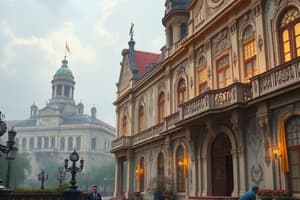Podcast
Questions and Answers
What does the red cap symbolize in relation to Marianne?
What does the red cap symbolize in relation to Marianne?
- Tradition and history
- Poverty and hardship
- Liberty and unity (correct)
- War and devastation
What characteristic is emblematic of Germania?
What characteristic is emblematic of Germania?
- Wearing a crown of olive leaves
- Holding a sword and shield
- Wearing a crown of oak leaves (correct)
- Draped in a blue and gold flag
How were Marianne's images used to promote national unity?
How were Marianne's images used to promote national unity?
- Featured in literature exclusively
- Marked on coins and stamps (correct)
- Displayed only in private homes
- Used in political campaigns
What does the term 'allegory' refer to in this context?
What does the term 'allegory' refer to in this context?
Where was the painting of Germania by Philip Veit intended to be displayed?
Where was the painting of Germania by Philip Veit intended to be displayed?
What was the primary role of Chief Minister Cavour in the unification of Italy?
What was the primary role of Chief Minister Cavour in the unification of Italy?
Which of the following statements reflects the sentiments of the Italian population during the unification?
Which of the following statements reflects the sentiments of the Italian population during the unification?
What significant event occurred in 1861 related to the unification of Italy?
What significant event occurred in 1861 related to the unification of Italy?
Who played a crucial role alongside Cavour in rallying support for the unification in southern Italy?
Who played a crucial role alongside Cavour in rallying support for the unification in southern Italy?
In what way did Cavour's background influence his approach to Italy's unification?
In what way did Cavour's background influence his approach to Italy's unification?
What is the primary social capital that underpins a national idea?
What is the primary social capital that underpins a national idea?
What significant change in governance did nationalism bring about in Europe during the 19th century?
What significant change in governance did nationalism bring about in Europe during the 19th century?
How is a nation described in the context of nationalism?
How is a nation described in the context of nationalism?
What role do inhabitants play in a nation according to the provided content?
What role do inhabitants play in a nation according to the provided content?
What is said about a nation’s interest in annexing other territories?
What is said about a nation’s interest in annexing other territories?
What drives the existence of nations as described?
What drives the existence of nations as described?
What is meant by the term 'plebiscite' in the context of a nation?
What is meant by the term 'plebiscite' in the context of a nation?
What is indicated about the practices of a modern state?
What is indicated about the practices of a modern state?
Which event marked the beginning of the revolutions of 1830 in Europe?
Which event marked the beginning of the revolutions of 1830 in Europe?
What was a significant result of the July Revolution in France?
What was a significant result of the July Revolution in France?
What was one major reform introduced by Napoleon in the regions under his control?
What was one major reform introduced by Napoleon in the regions under his control?
Which of the following describes the Napoleonic Code?
Which of the following describes the Napoleonic Code?
Who led the Greek struggle for independence and inspired support across Europe?
Who led the Greek struggle for independence and inspired support across Europe?
Which of the following social classes primarily led the revolutions in Europe during this period?
Which of the following social classes primarily led the revolutions in Europe during this period?
How did Napoleon's reforms impact communication and transport?
How did Napoleon's reforms impact communication and transport?
What was a notable effect of Napoleon's administrative reforms on the towns?
What was a notable effect of Napoleon's administrative reforms on the towns?
What cultural movement contributed to the development of nationalist sentiment in Europe?
What cultural movement contributed to the development of nationalist sentiment in Europe?
What general sentiment did the locals express towards the French armies as depicted in the painting?
What general sentiment did the locals express towards the French armies as depicted in the painting?
Which treaty formally recognized Greece as an independent nation?
Which treaty formally recognized Greece as an independent nation?
How did Romanticism influence the concept of nationalism?
How did Romanticism influence the concept of nationalism?
What was one outcome of incorporating revolutionary principles by Napoleon?
What was one outcome of incorporating revolutionary principles by Napoleon?
Which statement best describes the role of Lord Byron in the Greek war of independence?
Which statement best describes the role of Lord Byron in the Greek war of independence?
What aspect of civil rights was addressed by the Napoleonic Code?
What aspect of civil rights was addressed by the Napoleonic Code?
In which area did Napoleon aim to simplify administrative divisions?
In which area did Napoleon aim to simplify administrative divisions?
Flashcards are hidden until you start studying
Study Notes
Nationalism in Europe
- Nationalism emerged during the 19th century and led to the rise of the nation-state.
- Napoleon had a significant impact on the emergence of nationalism by implementing reforms across Europe.
- The Napoleonic Code, introduced in 1804, established equality before the law and secured the right to property.
- Napoleon's reforms were exported to regions under French control, leading to changes in administrative divisions, the abolition of feudal systems, and the freeing of peasants from serfdom.
- The July Revolution in France in 1830 sparked uprisings across Europe, including the Belgian revolt against the United Kingdom of the Netherlands.
- The Greek War of Independence (1821-1832), fueled by nationalist sentiments, resulted in Greece gaining independence from the Ottoman Empire.
- Romantic cultural movements contributed to the development of nationalist sentiment, using art, poetry, stories, and music to express and shape nationalist feelings.
- The unification of Italy was led by Count Camillo Benso di Cavour, who engineered a diplomatic alliance with France.
- Giuseppe Garibaldi, a revolutionary, led armed volunteers in the fight against Austrian forces and helped to unite southern Italy.
- The unification of Italy was proclaimed in 1861, but many members of the population remained unaware of nationalist ideology.
- France used Marianne as a national symbol of unity, representing liberty and the republic.
- Germania, represented as a woman wearing an oak leaf crown, became the allegory of the German nation.
Age of Revolutions (1830-1848)
- As conservative regimes consolidated their power, liberalism and nationalism became associated with revolutions.
- Revolutions were led by liberal-nationalists from the educated middle class, including professors, teachers, clerks, and commercial middle class members.
- The first upheaval in this period occurred in France in July 1830, leading to the overthrow of the Bourbon kings and the establishment of a constitutional monarchy under Louis Philippe.
- The July Revolution inspired an uprising in Brussels, resulting in Belgium's separation from the United Kingdom of the Netherlands.
- The Greek War of Independence (1821-1832), sparked by the growth of revolutionary nationalism in Europe, saw Greeks struggle for independence from the Ottoman Empire.
The Romantic Imagination and National Feeling
- The growth of nationalism wasn't solely driven by wars and territorial expansion.
- Culture, particularly Romanticism, significantly contributed to the formation of the idea of the nation.
- Art, poetry, stories, and music helped to express and shape nationalist feelings.
Unification of Italy
- Count Camillo Benso di Cavour, a skilled diplomat, led the movement to unify Italy.
- Cavour strategically allied Sardinia-Piedmont with France, leading to victory against Austrian forces in 1859.
- Giuseppe Garibaldi, a prominent revolutionary, led armed volunteers, gaining support from peasants in southern Italy.
- In 1861, Victor Emmanuel II was proclaimed king of a unified Italy.
National Symbols
- France utilized Marianne as a national symbol representing liberty, the republic, and unity.
- Germania, adorned with an oak leaf crown, represented the German nation, symbolizing heroism and strength.
Studying That Suits You
Use AI to generate personalized quizzes and flashcards to suit your learning preferences.




